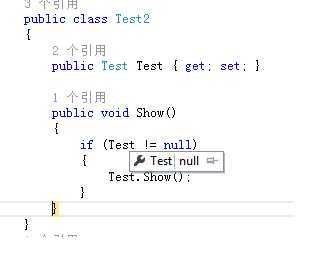标签:style blog http io color ar os 使用 sp
Autofac 是一款优秀的IOC的开源工具,完美的适配.Net特性,但是有时候我们想通过属性注入的方式来获取我们注入的对象,对不起,有时候你还真是获取不到,这因为什么呢?
1.你对Autofac 不太了解,在这个浮躁的社会,没有人会认真的了解每个开源项目,只要求能用就行
2.没有时间了解,你是一个很忙的人,工作很忙,应酬很忙
3.刚开始使用Autofac 还没来得及深入了解就要做项目。
不管是什么原因,总之我们注入的属性就是无法直接由autofac 自动注入,或者说我们希望由Autofac自动注入的属性为Null,这可是很让我们纠结的事情。下面我们就来通过一系列我们可能的操作来还原事情的真相。
真相1:通过registerType注册类型,希望通过属性获取注入的类型。
1 class Program 2 { 3 static void Main(string[] args) 4 { 5 ContainerBuilder builder = new ContainerBuilder(); 6 // builder.RegisterModule(new LoggingModule()); 7 builder.RegisterType<Test>(); 8 builder.RegisterType<Test2>(); 9 var container = builder.Build(); 10 11 Test2 test2 = container.Resolve<Test2>(); 12 test2.Show(); 13 14 } 15 } 16 17 public class Test { 18 public void Show() 19 { 20 Console.WriteLine("FileName"); 21 } 22 } 23 24 public class Test2 25 { 26 public Test Test { get; set; } 27 28 public void Show() 29 { 30 if (Test != null) 31 { 32 Test.Show(); 33 } 34 } 35 }
我们通过RegisterType注入了两个类型Test和Test2,其中Test2中由一个属性为Test类型的Test变量,我们期望Test会自动注入,我们可以直接使用Test.Show方法,但是现实情况是:

我们期望会被Autofac自动注入的属性为Null,我们的期望落空。既然通过RegisterType无法注入,那么通过Register注入呢,是否可行呢?
1 class Program 2 { 3 static void Main(string[] args) 4 { 5 ContainerBuilder builder = new ContainerBuilder(); 6 // builder.RegisterModule(new LoggingModule()); 7 //builder.RegisterType<Test>(); 8 9 10 builder.Register(t => new Test()).As<Test>(); 11 builder.RegisterType<Test2>(); 12 var container = builder.Build(); 13 14 Test2 test2 = container.Resolve<Test2>(); 15 test2.Show(); 16 17 } 18 } 19 20 public class Test { 21 public void Show() 22 { 23 Console.WriteLine("FileName"); 24 } 25 } 26 27 public class Test2 28 { 29 public Test Test { get; set; } 30 31 public void Show() 32 { 33 if (Test != null) 34 { 35 Test.Show(); 36 } 37 } 38 }
我们通过Register注入一个实例,最后我们的期望还是落空了,还有一种方式就是通过Module进行注册,这种方式还不行,那就说明autofac的属性注入式骗人的(心里想的),我们来通过Module来实现。
真相3:通过module进行注册
1 class Program 2 { 3 static void Main(string[] args) 4 { 5 ContainerBuilder builder = new ContainerBuilder(); 6 builder.RegisterModule(new LoggingModule()); 7 //builder.RegisterType<Test>(); 8 9 10 //builder.Register(t => new Test()).As<Test>(); 11 //builder.RegisterType<Test2>(); 12 var container = builder.Build(); 13 14 //Test2 test2 = container.Resolve<Test2>(); 15 Test2 ee = new Test2(); 16 ee.Show(); 17 18 } 19 } 20 21 public class Test { 22 public void Show() 23 { 24 Console.WriteLine("FileName"); 25 } 26 } 27 28 public class Test2 29 { 30 public Test Test { get; set; } 31 32 public void Show() 33 { 34 if (Test != null) 35 { 36 Test.Show(); 37 } 38 } 39 } 40 public class LoggingModule : Module 41 { 42 private readonly ConcurrentDictionary<string, Test> _loggerCache; 43 44 public LoggingModule() 45 { 46 _loggerCache = new ConcurrentDictionary<string, Test>(); 47 } 48 49 protected override void Load(ContainerBuilder moduleBuilder) 50 { 51 // by default, use Coevery‘s logger that delegates to Castle‘s logger factory 52 moduleBuilder.RegisterType<Test>().As<Test>().InstancePerLifetimeScope(); 53 54 55 // call CreateLogger in response to the request for an ILogger implementation 56 // moduleBuilder.Register(CreateLogger).As<ILogging.ILogger>().InstancePerDependency(); 57 58 } 59 60 protected override void AttachToComponentRegistration(IComponentRegistry componentRegistry, IComponentRegistration registration) 61 { 62 var implementationType = registration.Activator.LimitType; 63 64 // build an array of actions on this type to assign loggers to member properties 65 var injectors = BuildLoggerInjectors(implementationType).ToArray(); 66 67 // if there are no logger properties, there‘s no reason to hook the activated event 68 if (!injectors.Any()) 69 return; 70 71 // otherwise, whan an instance of this component is activated, inject the loggers on the instance 72 registration.Activated += (s, e) => 73 { 74 foreach (var injector in injectors) 75 injector(e.Context, e.Instance); 76 }; 77 } 78 79 private IEnumerable<Action<IComponentContext, object>> BuildLoggerInjectors(Type componentType) 80 { 81 // Look for settable properties of type "ILogger" 82 var loggerProperties = componentType 83 .GetProperties(BindingFlags.SetProperty | BindingFlags.Public | BindingFlags.Instance) 84 .Select(p => new 85 { 86 PropertyInfo = p, 87 p.PropertyType, 88 IndexParameters = p.GetIndexParameters(), 89 Accessors = p.GetAccessors(false) 90 }) 91 .Where(x => x.PropertyType == typeof(Test)) // must be a logger 92 .Where(x => x.IndexParameters.Count() == 0) // must not be an indexer 93 .Where(x => x.Accessors.Length != 1 || x.Accessors[0].ReturnType == typeof(void)); //must have get/set, or only set 94 95 // Return an array of actions that resolve a logger and assign the property 96 foreach (var entry in loggerProperties) 97 { 98 var propertyInfo = entry.PropertyInfo; 99 100 yield return (ctx, instance) => 101 { 102 string component = componentType.ToString(); 103 var logger = _loggerCache.GetOrAdd(component, key => ctx.Resolve<Test>(new TypedParameter(typeof(Type), componentType))); 104 propertyInfo.SetValue(instance, logger, null); 105 }; 106 } 107 }
我们通过Module注册了Test,但是我们通过断点调试可以看到,我们通过属性注入的还是没有得到,还是为Null,这是不是autofac不支持属性注入,我们在心里只骂坑爹啊。

但是我们仔细看一下会发现一个问题,我们的Test2 是通过New得到的,而不是通过autofac得到,我们并没有将Test2注入到autofac中,是不是因为这个愿意呢?
我们来尝试一下,这可是我最后的机会了,因为除了这个原因我实在想不出还有什么别的原因。
1 static void Main(string[] args) 2 { 3 ContainerBuilder builder = new ContainerBuilder(); 4 builder.RegisterModule(new LoggingModule()); 5 //builder.RegisterType<Test>(); 6 7 8 //builder.Register(t => new Test()).As<Test>(); 9 builder.RegisterType<Test2>(); 10 var container = builder.Build(); 11 12 Test2 test2 = container.Resolve<Test2>(); 13 // Test2 ee = new Test2(); 14 test2.Show(); 15 16 }
我们修改了一下代码,将Test2也注入到Autofac中,然后通过autofac的resolve获取,奇迹出现了,我们看到了我们注册的类型,在属性注入得到了我们想要的实例。
这不得不说是一个令我激动的事情,因为这个属性得到的实在是太难,让我尝试了很多种,经历了很多次绝望。
所以我发现,如果你要想实现autofac的自动属性注入,由三个步骤,第一个通过module注册你要通过属性获取的类型,第二个,在属性所在的class中,也要注册到autofac中,最后一点,获取属性所在的class的实例必须通过autofac获取,也就是绝对不要通过new来获取,因为autofac的存在就是为了让你在一定程度上减少new的使用。
我们使用过autofac的MVC实现,我们发现在controller中可以得到我们的属性值,那是因为controller已经注册到了autofac中,因为肯定有一句builder。registerController的存在。
所在对于想实现autofac自动属性注入的朋友,一定要记得将类型通过module注入到autofac。并且属性所在的类型必须通过autofac获取,因为我们必须让autofac知道类型的存在,才可能会自动注入。
这是一篇说明文,简短的说明,希望没有高深的知识点,但是如果你不了解,会花费很长时间才可能查找到错误的地方。应验了那句话,知道了不难,不知道了难上加难。
我的座右铭:做架构师,要做牛逼的架构师。
标签:style blog http io color ar os 使用 sp
原文地址:http://www.cnblogs.com/jiagoushi/p/4084145.html